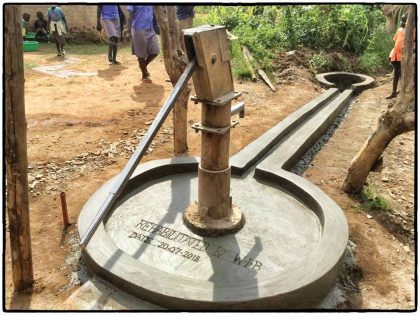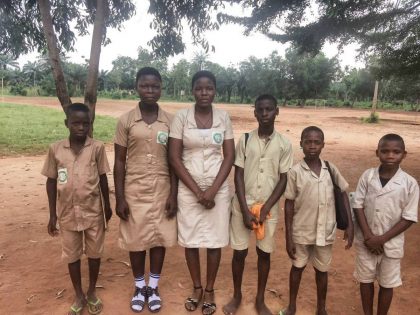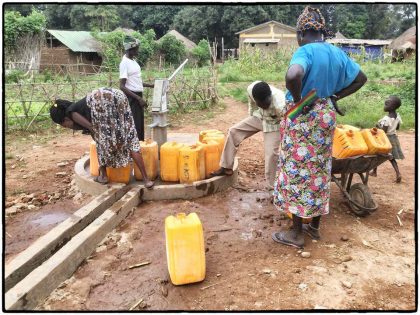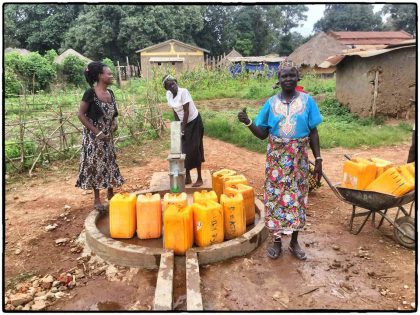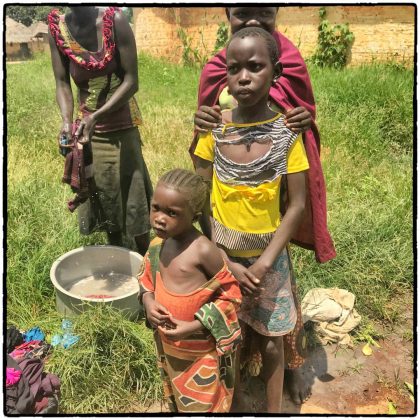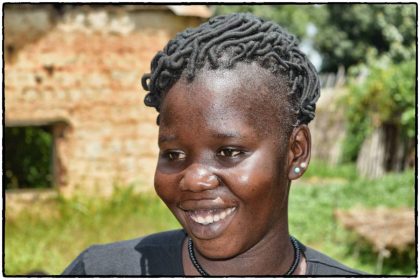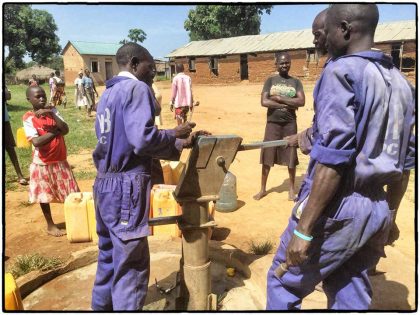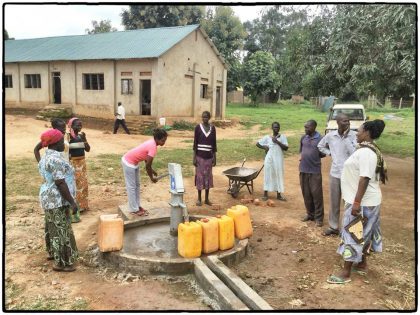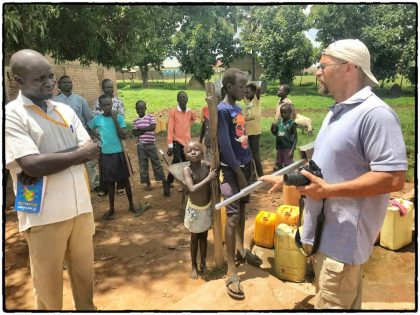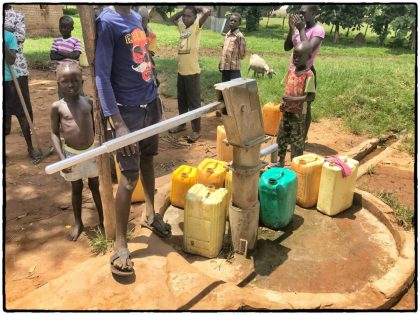Part 2 of Phase 4 in the South Sudan Well Rehab Program
The second 5 wells of 20!
These 5 well repairs have been finished in the South Sudan Well Rehab Program Phase IV. Follow the link for an overview of the program.
Water Charity’s South Sudan Relief Wells 6 – 10 (with Conclusion Reports)
6. Hai Gabat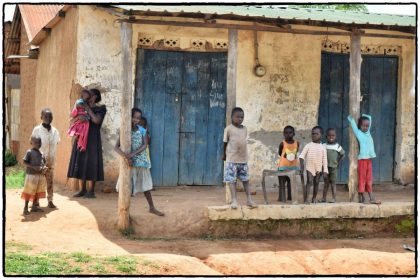
Location
Hai Gabat, Yei River State, South Sudan
GPS- N 04* 05.681 E 30* 41.287
Community Description
Hai Gabat is a community that is home to many IDPs (Individually Displaced Persons). UNCHR, UMCOR, and the local church have supported those that have been displaced to this area. Hai Gabat is in a central location where many storefronts line the road. They have since shut down with the conflict and are just beginning to reopen as several store owners have returned to their community. Their main source of income is farming.
Problem Addressed
In 2017, the South Sudan conflict-hit Hai Gabat. Many of the storefronts that line the main road just meters away from the borehole shut down as shop owners left to seek security. This is an area where UMOCR (United Methodist Committee on Relief), UNCHR (The UN Refugee Agency) and the local church supported people who were internally displaced. The borehole was abandoned as even new community members had to flee last year temporarily. 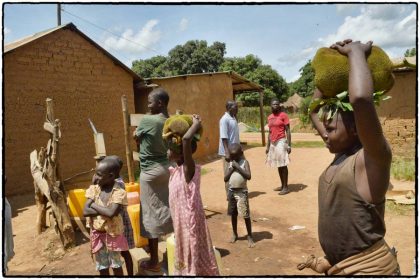
As peace is realized in Yei, community members are making their way back home to Hai Gabat and storefronts are beginning to reopen. Without access to functioning well, it is tough for community members to resettle. Time must be spent traveling to other boreholes where they pay high fees to collect water.
Waru Moses, a community member that never left his home in Hai Gabat, even during the conflict, shared about the recent history of this well. In 2017, the GI pipes were replaced by a contracted organization, but the quality of the pipes was inferior, and when left abandoned, they quickly corroded.
Nensi, a grandmother with grown children of her own, took in her grandchildren when her daughter died a year ago. Her daughter lost her life shortly after giving birth, and so Nensi is left with children to care for that range from one year to adulthood. The children by her side have all experienced trauma and stick 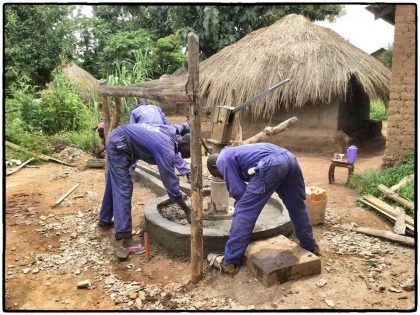 together doing what they can to help each other with basic needs. Two children walked passed the well carrying massive jackfruits on their heads that they found for their family to eat that day.
together doing what they can to help each other with basic needs. Two children walked passed the well carrying massive jackfruits on their heads that they found for their family to eat that day.
Project Impact
With access to clean water, Nensi, her children, and her grandchildren will have better health and more time to do more than work to get clean water each day. With community members returning and IDPs resettling in this area, this well will currently serve up to 800 people as well as offer relief to those traveling along the main road. The number of returnees to the community grows daily, so that number will likely double in a month.
Conclusion Report
The Water is Basic team spent two hours replacing the corroded GI pipes. It took a day to rebuild the base of the borehole. This will allow the water to flow correctly to be used to irrigate their crops and not pool unnecessarily.
With access to clean water, Nensi, her children, and her grandchildren will have better health and more time to do more than work to get clean water each day. With community members returning and IDPs resettling in this area, this well currently serves up to 800 people as well as offers relief to those traveling along the main road. The number of returnees to the community grows daily, so that number will likely double in a month.
7. Hai Gufa
Location
Hai Gufa, Yei River State, South Sudan
GPS- N 04* 05.188 E 30* 40.346 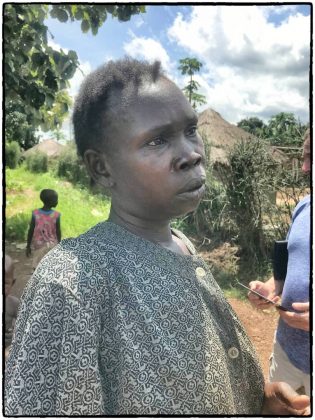
Community Description
Hai Gufa is located 1.5 miles from the market of Dar Salaam. The people in this community rely on agriculture to support their families.
Problem Addressed
The borehole in this community once served 150 households. When fighting broke out in Yei in 2017, many other families seeking security made their way to this community that is 1.5 miles away from town. An estimated 2000 people were using this well for relief, and no fees were charged during that time.
Now that peace is realized in this area and people are resettling to their communities, the borehole at Hai Gufa will continue to serve an average of 900 people. But the overuse of the well-led to parts being damaged, and now it is in need of repair.
Suzie, a committee member of the well at Hai Gufa, says she has to pump a long time before water comes out. After 30 minutes of pumping, she can fill three to four jerry cans and then the water stops. Many in the community go to the boreholes in Hai Gufa 2 or Hai Leben to fill their jerry cans.
Suzie has eight children, seven of whom are in school. The monthly cost for one child per term is 300 SS pounds which is more than she currently earns selling greens in the Dar Salaam Market once a week. She continues to use this well as she cannot afford to pay fees for water, and it is too difficult for her to carry the jerry cans to neighboring wells with her young child in tow. As a committee member of the well, she is committed to continuing to oversee the maintenance of the well and the area that surrounds it.
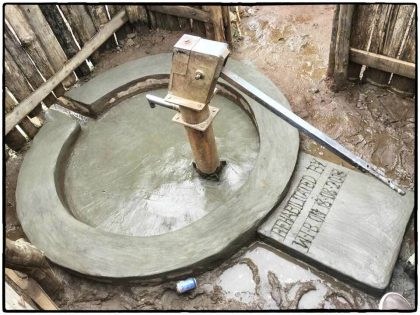 Project Impact
Project Impact
The repair of this borehole will allow it to once again serve the 900 people in the community and hundreds of others that are returning, potentially reaching up to 2000 once again. It will alleviate the economic burden people have as they will no longer pay higher fees in neighboring communities. It will bring health to many who cannot pay the fees or wait for water and who have resorted to drinking water from the stagnant pond nearby.
Conclusion Report
The crew spent two days repairing the well at Hai Gufa. Several metal bearings were worn, and the pump handle was loose. These were simple repairs that took less than one hour. The extensive repair work was done to the base of the borehole. The team took two days to re-cement the base so that dirty, stagnant water would no longer drip through the cracks of the base corroding the clean, pumped water.
The repair of this borehole allows it to serve once again the 900 people in Hai Gufa community and hundreds of others that are returning. This well has the potential of reaching up to 2000 people once again. It will alleviate the economic burden of people like committee member, Suzie who will no longer pay higher fees in neighboring communities. It will bring health to many who cannot pay the fees or wait for water and who have resorted to drinking water from the stagnant pond nearby.
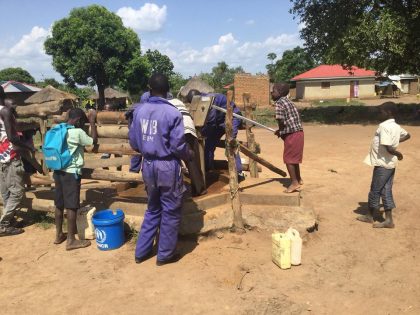
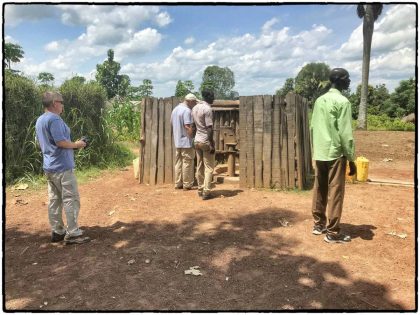
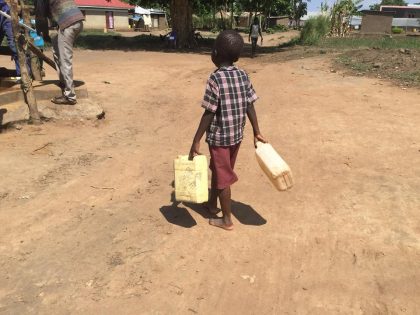
8. Yei Prison
Location 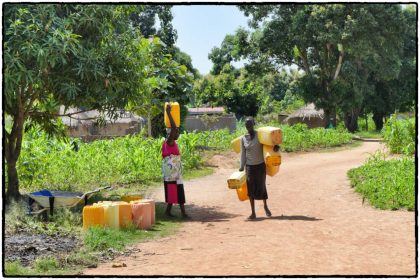
Yei Prison, Yei River State, South Sudan
GPS- N 04* 05.570 E 30* 40.729
Community Description
The Yei Prison located in the city center of Yei. Currently, there are 107 prisoners and 20 guards and administrators at the prison.
Problems Addressed
There are two wells inside the walls of Yei Prison. Prisoners have a designated amount of time that they must serve in their cells and are to be in their cells each day by 5 pm. With limited time outside of their cells, they use the wells for drinking, watering plants, washing, and cooking. One borehole was repaired six months ago, and immediately the other one broke. It is crucial for two to operate as a broken well makes it difficult for prisoners to serve their full term.
The prisoners are in charge of maintaining the boreholes. They are very well kept, and the runoff from the wells are designed to irrigate the crops. The crops surrounding the broken borehole are suffering, and there is little time for the prisoners to fetch water from the functioning borehole to water them. With fewer plants, there is less food for the prisoners as they boil the plants daily as a part of their meal.
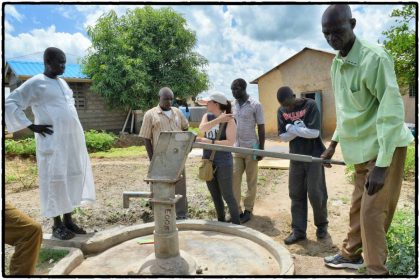 Project Impact
Project Impact
Restoring the well at the prison will alleviate tension among the prisoners all needing to gain access during their limited time out of their cells. Restoring this well also allows the Water is the Basic team to have a positive relationship with the local police whose support is needed as the WiB team moves freely throughout Yei to bring water to communities.
Conclusion Report
The well at Yei prison was a 3-day project. It needed extensive repairs including new GI pipes, a new pump head and the cement base of the well was redone to allow proper flow of the water.
When the well was reopened on August 8, 2018, many community members gathered to fill their jerry cans with water. While the well is within the walls of Yei Prison and maintained by the prisoners, community members are allowed in to gain access to the clean water during certain scheduled times during the day. These community members had to walk a great distance to fetch water when the well was in need of repair. While there is a second one on site, there was no time for community members to wait in line as the prisoners needed the use of the well for drinking and chores throughout the day. With both wells functioning properly, prisoners, guards, and community members all benefit with close access to clean, fresh water.
Restoring the well at the prison will alleviate tension among the prisoners all needing to gain access during their limited time out of their cells. Restoring this well also allows the Water is Basic team to have a positive relationship with the local police whose support is needed as the WiB team moves freely throughout Yei to bring water to communities.
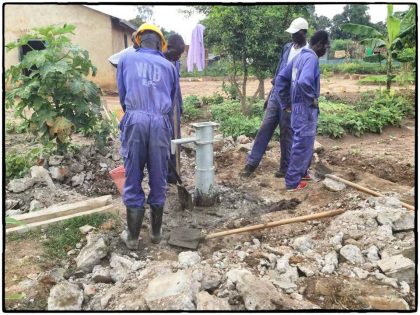
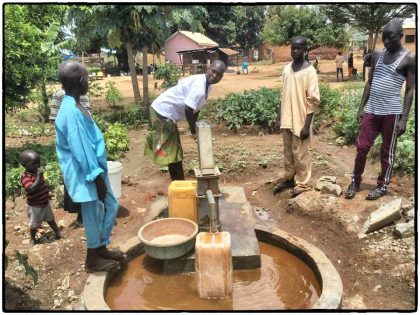
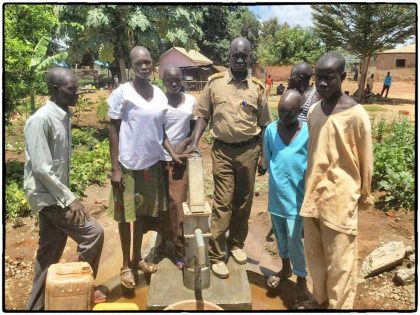
9. Hai Simba 1
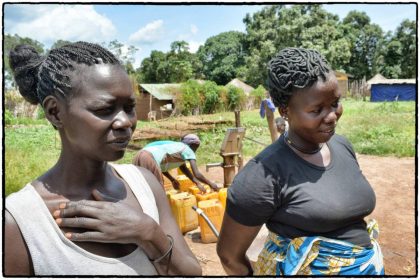 Location
Location
Hai Simba 1, Yei River State, South Sudan
GPS- N 04* 05.441 E 30* 40.832
Community Description
Hai Simba is a busy community with about 1000 households between the two boreholes that are 3 kilometers apart; Hai Simba 1 and Hai Simba 2. IDP (Internally Displaced Persons) have been relocated to this area, so the number of people here has grown over the past two years.
Problem Addressed
The Hai Simba 1 borehole was first drilled in 2008 by the Water is the Basic team. It has been a decade, and no repairs have been made to this borehole. four months ago, it became increasingly difficult to use the hand pump and the water began turning brown as the GI pipes are now corroded.
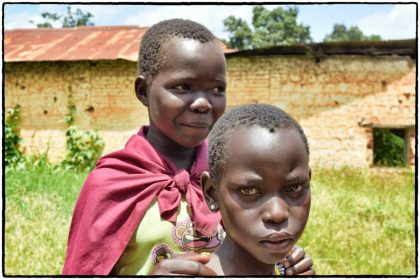 Joy Tabu is a committee member of this borehole. She has three children that help her fetch water for her family and her aging parents. She has been on the water committee for five years and says that they work well together to maintain the borehole and manage the fees collected. Joy noted that there are eight people on the committee, five of whom are women. It is crucial that women are on the teams that oversee the wells as it is their job to get the water daily. They will do all they can to ensure the well works appropriately because their days change dramatically when having to spend more time fetching water, paying high fees or when they have to resort to getting water from a stagnant pond.
Joy Tabu is a committee member of this borehole. She has three children that help her fetch water for her family and her aging parents. She has been on the water committee for five years and says that they work well together to maintain the borehole and manage the fees collected. Joy noted that there are eight people on the committee, five of whom are women. It is crucial that women are on the teams that oversee the wells as it is their job to get the water daily. They will do all they can to ensure the well works appropriately because their days change dramatically when having to spend more time fetching water, paying high fees or when they have to resort to getting water from a stagnant pond.
Florence stood by the well with her children washing clothes as the well was surveyed. She said it is much more difficult to carry on daily tasks having to wait longer to access the water. Florence has no choice but to wash her clothes and fill her jerry cans with rusty water. She does not have the income to pay fees she would have to pay at a neighboring community and does not have the time to wait in line at the Hai Simba 2 borehole which is also in need of repair.
Project Impact
The repair of Hai Simba 1 will serve an estimated 3000 people including IDPs that have had to leave their own homes to seek security.
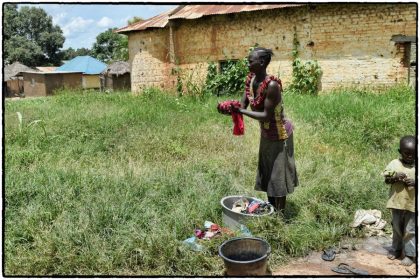 Conclusion Report
Conclusion Report
The well was repaired and serves over 3,000 people. This is a lot of people to use one well, but because Hai Simba 2 well was also repaired, community members closest to that well will no longer wait in line at Hai Simba 1.
There are separate committees for these wells, but they work together to share best practices. While many locations must re-establish their well committees, most of the committee members for Hai Simba 1 did not leave during the conflict. They are proud to reopen their well. On the day that it was opened, committee members had jerry cans lined up and ready to go. This well will provide relief for these families with fresh water to drink and cook with and to complete their daily chores.
10. Hai Simba 2
Location
Hai Simba 2, Yei River State, South Sudan
GPS- N 04* 05.355 E 30*41.133 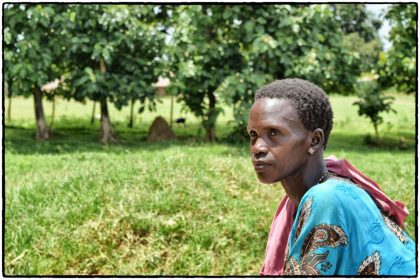
Community Description
Hai Simba is a bustling community with about 1000 households between the two boreholes that are three kilometers apart; Hai Simba 1 and Hai Simba 2. It is located along a busy road where people travel to the market on a daily basis, and many who are displaced use this well for relief.
Problem Addressed
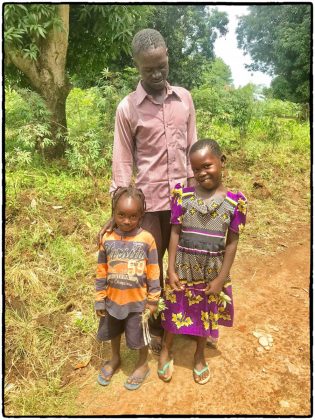 There are an estimated 3000 people that use the well at Hai Simba 2. It is a very busy area that serves not only community members, but many that have been displaced from their own homes over the past two years.
There are an estimated 3000 people that use the well at Hai Simba 2. It is a very busy area that serves not only community members, but many that have been displaced from their own homes over the past two years.
The GI pipes have rusted as indicated by the brown water pumped out of the well. The hand pump is loose and in need of repair. Those that use this well must pump twice as much as they once did to get water to begin to flow.
Moses is the chairman of the Hai Simba 2 well committee. There are twelve members, four of whom are women. Moses is a community health worker and says that the majority of the patients he sees, suffer from malaria. The runoff water from this well does not properly drain and creates a pool of stagnant water that is breeding ground for mosquitoes that carry disease.
The well technicians plan to replace the GI pipes and restore the hand pump and any other parts they find that need to be replaced. The well committee has agreed to build a fence around the well to protect the borehole and to control the range of motion of the handpump. They will also dig a drainage ditch so that the water no longer pools at the end of the structure. 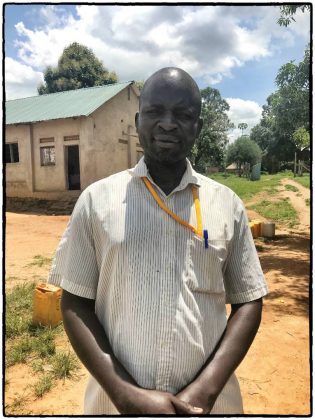
With so many people in need of water between the wells at Hai Simba 1 and Hai Simba 2 and the decreased functionality of the two wells, fees are no longer collected. People are desperate to access water where they can, and with the added burden of high inflation, they cannot afford to pay for their basic needs. The majority of people in Hai Simba are accessing water from ponds and streams nearby that are contaminated.
Project Impact
The repair of Hai Simba 2 will serve an estimated 3000 people. The renovations will lead to better health for the community members and internally displaced people as it will alleviate waterborne diseases that cause people to suffer. It is anticipated that the number of malaria cases will decrease as the drainage from the well will be maintained appropriately.
Conclusion Report
The repair of Hai Simba 2 has served over 3000 people. It is already contributing to better health, and we have seen a marked decrease in waterborne diseases.
The crew replaced GI pipes as well as several worn metal bearings. Once those necessary repairs were made, the team restored the concrete base and drain surrounding the borehole. It is anticipated that the number of malaria cases will decrease as the drainage from the well will be maintained appropriately by the well committee.
